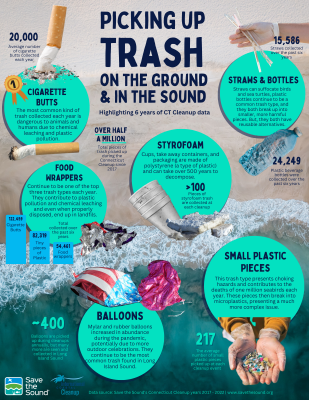 In its first Connecticut Cleanup Report, Save the Sound showcases its annual cleanup efforts , which have been made possible by thousands of dedicated volunteers and long-standing corporate sponsors including Subaru of New England, FactSet, HMTX Industries, Barrett Outdoor Communications, Oris Watches, and Arvinas.
In its first Connecticut Cleanup Report, Save the Sound showcases its annual cleanup efforts , which have been made possible by thousands of dedicated volunteers and long-standing corporate sponsors including Subaru of New England, FactSet, HMTX Industries, Barrett Outdoor Communications, Oris Watches, and Arvinas.
Trash is hazardous to people, animals, and the planet. Plastic trash in particular presents severe threats to our own health and that of wildlife and is ubiquitous in our region’s streams, marshes, parks, and beaches. Macro and micro plastics are hazardous at every level of the food chain; Larger pieces suffocate marine life and smaller pieces carry toxins that bioaccumulate in fish tissue that we consume.
“Over 600 marine species have been reported to be adversely affected by plastic,” Save the Sound’s Associate Soundkeeper, Emma DeLoughry, said in a news release, “and yet we continue to produce an enormous amount of it, and only use most of it once before disposing of it. For example, a plastic straw may only be used for 30 minutes yet takes hundreds of years to break down. Ending single-use plastics and removing plastic trash from our natural spaces can help mitigate what has become a global issue.”
The Connecticut Cleanup Report highlights both the scale and impact of litter in Connecticut and is intended to be a resource for bringing attention and will to the task of changing the way we consume single-use plastics and other types of trash. It also represents the continual collection of data by our volunteers. This data—types of trash, number of pieces, total weight, and more—are used to advocate for policy change in Connecticut and beyond to stop trash at its source.
The data indicate that cigarette butts, food wrappers, and small plastic pieces have been the top three most common trash types for the past six years. The data also show Styrofoam and balloons as persistent trash types on the ground and in the Sound. On average, Save the Sound volunteers collect over 100 pieces of Styrofoam trash at each cleanup and over 400 Mylar or rubber balloons each year. All of these types of trash pose serious threats to human and animal health including ingestion, suffocation, and chemical leaching. Additionally, any plastic trash contributes to the growing abundance of microplastics as they break up into smaller and smaller pieces that become increasingly difficult to remove from the environment.